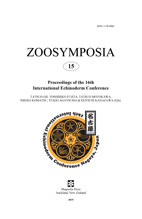Abstract
Microfossils in the form of wheels are characteristic of Holothuroidea and Ophiocistioidea (Echinodermata). Only a few wheel fossils have been ever reported without detailed description from Japan. Five wheel fossils were collected from the Carboniferous part of the Omi Limestone distributed in Itoigawa City, Niigata Prefecture, central Japan. The Limestone is included in the Akiyoshi Terrane generated by accretion of seamounts in the trench area. These wheels were identified as Protocaudina botoni (Gutschick, 1959) (Ophiocistioidea, Rotasacciidae) and Thalattocanthus consonus Carini, 1962 (Holothuroidea, Synaptida, Theeliidae). The diagnosis of the genus Protocaudina Croneis, 1932 has been revised to cover all current valid species. The Limestone was deposited as a reef carbonate on a pelagic, shallow-water seamount suggesting that these species habitats were distributed in the pelagic environments.

